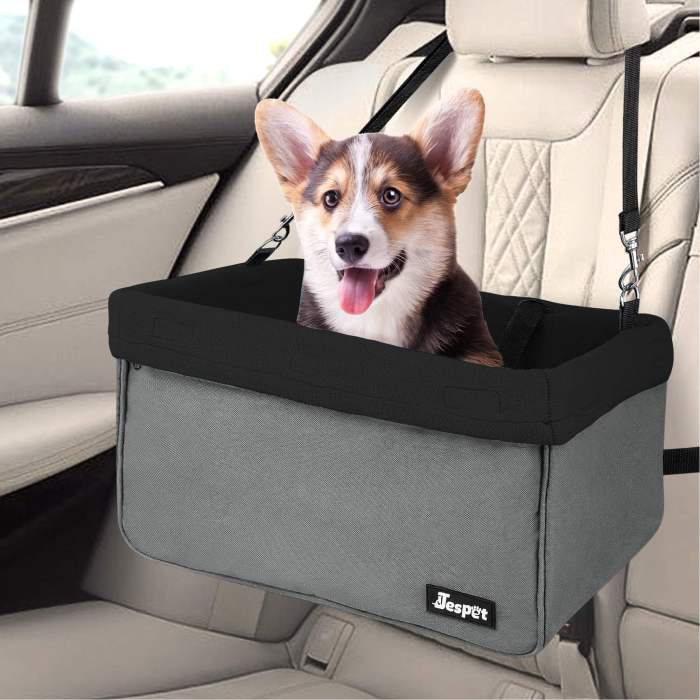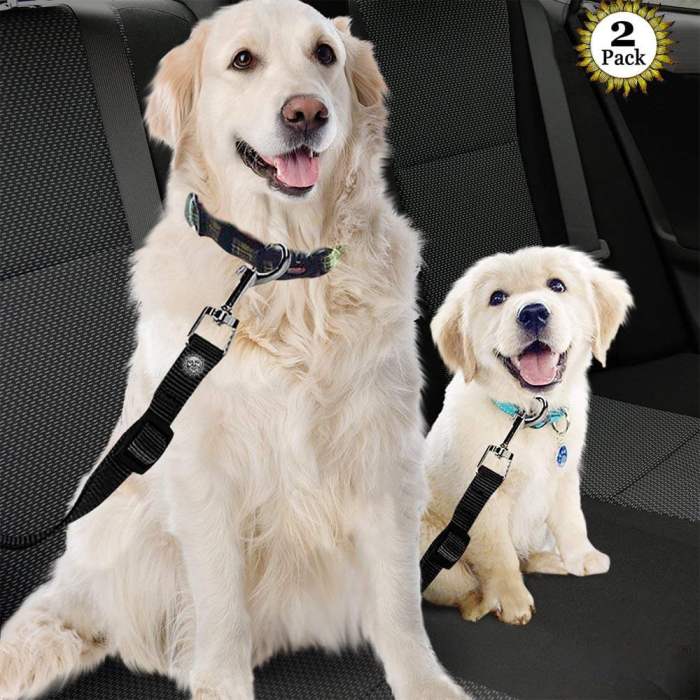Pet seat belts for dogs in cars: Seriously, it’s not just about keeping Fido from launching himself into your lap during a sudden stop. We’re talking life-or-death stuff here. A properly fitted seat belt could be the difference between a minor fender bender and a major tragedy for your furry best friend. This isn’t just about following the law; it’s about keeping your pup safe and sound on every adventure.
This guide dives into the world of pet car safety, covering everything from choosing the right harness to understanding the legal ramifications of an unrestrained pup. We’ll tackle common behavioral issues, explore alternative safety measures, and even walk you through some real-life scenarios to highlight the importance of buckling up your best pal. Get ready to become a certified car-safety expert for your canine companion!
Safety Features of Pet Seat Belts

Keeping your furry friend safe during car rides is crucial, and a properly fitted pet seat belt is a key component of responsible pet ownership. While many people assume a simple harness will suffice, understanding the different types of pet restraints and their features is vital for ensuring your dog’s safety and minimizing the risk of injury in the event of an accident.
Types of Pet Seat Belts and Their Features
Choosing the right pet seat belt depends on your dog’s size, breed, and temperament. Several options exist, each with its advantages and disadvantages. The following table compares three common types: harnesses, tethers, and seat belt attachments.
| Feature | Harness | Tether | Seat Belt Attachment |
|---|---|---|---|
| Type of Restraint | Wraps around the dog’s torso | Connects to a dog’s existing harness | Clips directly onto a vehicle’s seat belt |
| Security | Generally offers the most secure restraint | Moderate security, depends on the quality of the harness and tether | Security depends heavily on the quality of the attachment and the vehicle’s seatbelt system |
| Comfort | Can be more comfortable for longer journeys | Comfort depends on the harness used | Can be less comfortable for some dogs, may restrict movement |
| Price Range | $15 – $50+ | $10 – $30 | $5 – $25 |
| Suitability | Suitable for most dogs, especially larger breeds | Suitable for most dogs, but requires a compatible harness | Best for smaller dogs or those who don’t require extensive movement |
| Examples | Many brands offer step-in harnesses with integrated seat belt attachments | Often a simple strap with a clip for connecting to a harness | Usually a simple clip that attaches to a standard seat belt |
Proper Fitting and Adjustment
A poorly fitted pet seat belt, regardless of type, can be ineffective and even dangerous. Improperly adjusted harnesses can cause discomfort, restrict breathing, or allow too much movement during braking or collisions. Always follow the manufacturer’s instructions carefully. The harness or tether should be snug but not constricting. Your dog should be able to comfortably sit, stand, and lie down, but there should be minimal slack.
Regularly check the fit as your dog grows. For tethers, ensure the connection between the tether and the harness is secure and the tether itself is appropriately taut. For seat belt attachments, make sure the clip is securely fastened to both the seat belt and the pet’s harness or carrier.
Safety Standards and Certifications
While there isn’t a single, universally recognized safety standard for pet seat belts, reputable manufacturers often adhere to voluntary guidelines and undergo independent testing. Look for products that meet or exceed relevant automotive safety standards, such as those relating to strength and durability. Some manufacturers may also highlight testing results, indicating the product’s ability to withstand certain forces.
Okay, so pet seat belts are a total must-have for any dog owner, right? Keeping your furry friend safe is key, but even with a harness, winter drives can be brutal. To keep you warm while keeping your pup secure, check out this guide for Best heated seat covers for winter 2025 – then you can both enjoy the ride, safely and comfortably.
Seriously, those heated seats are a game-changer, especially when combined with a good pet seat belt.
Checking online reviews and ratings can also help you assess the safety and reliability of a particular brand or model. Avoid products that lack clear safety information or testing data.
Legal and Regulatory Aspects
Keeping your furry friend safe while traveling involves more than just a comfy car seat; it also touches on legal responsibilities. Laws regarding pet restraint in vehicles vary widely, and understanding these regulations is crucial for responsible pet ownership and to avoid potential legal trouble. Failure to properly secure your pet can lead to serious consequences, impacting both you and your animal companion.Laws and regulations concerning pet restraints in vehicles differ significantly across jurisdictions.
Some areas have specific laws mandating pet restraint, while others rely on more general traffic safety laws that can be interpreted to include pets. Understanding your local regulations is paramount.
Pet Restraint Laws by Location
The legal landscape surrounding pet restraint in cars is a patchwork across the globe. There’s no single, universal law. For example, some countries, like Australia, have seen increased focus on pet safety in vehicles, with some states enacting stricter rules than others. In contrast, many US states currently lack specific laws addressing pet restraint, relying instead on broader “negligence” laws.
This means that if an unrestrained pet causes an accident, a driver could be held liable for damages. It’s vital to research your specific location’s laws.
- Australia: Specific laws vary by state and territory, but a general trend toward stricter enforcement and increased public awareness is observable. Some areas have specific legislation relating to secure transportation of animals in vehicles.
- United States: Many states lack specific laws regarding pet restraint. However, drivers can be held liable under general negligence laws if an unrestrained pet causes an accident or injury.
- European Union: Regulations vary across member states, with some countries having clearer guidelines than others. Many countries encourage responsible pet transportation but lack specific, enforceable laws.
Legal Consequences of Unrestrained Pets
Driving with an unrestrained pet carries several potential legal consequences. These consequences can range from fines and citations to more severe penalties, depending on the specifics of the situation and the jurisdiction. The severity of the consequences is often directly related to the harm caused by the unrestrained animal.For instance, if an unrestrained pet causes a collision, the driver may face charges of reckless driving or even more serious offenses.
This is because an unrestrained animal can significantly impair a driver’s control of the vehicle, increasing the risk of accidents. Additionally, if the unrestrained pet causes injury to a passenger or another person, the driver could face criminal charges or civil lawsuits. The cost of such lawsuits could be substantial.
Insurance Company Involvement in Accidents Involving Unrestrained Pets
Insurance companies play a crucial role in accidents involving unrestrained pets. The outcome of an insurance claim can be significantly affected by whether or not the pet was properly restrained. Insurance companies may deny or reduce coverage if they determine that the driver’s failure to restrain their pet contributed to the accident. This means that the driver might be responsible for paying for damages out of pocket.
Furthermore, if the unrestrained pet caused injury to another person or their property, the driver’s insurance may be held liable for the resulting damages, potentially leading to increased premiums or policy cancellation. It’s vital to maintain comprehensive coverage and discuss pet-related accident scenarios with your insurance provider.
Dog Behavior and Seat Belt Use

Getting your dog used to a car seat belt might seem straightforward, but many pups have strong reactions to the restraint. Understanding these reactions and employing positive training techniques is key to a safe and stress-free car ride for both you and your furry friend. Failure to properly acclimate your dog can lead to anxiety, escape attempts, and even injuries.Many dogs initially resist seat belts.
This resistance stems from a variety of factors, including a natural aversion to feeling confined, a dislike of the unfamiliar sensation of the harness, or simply a preference for roaming freely within the vehicle. Anxiety is a common reaction, manifesting as whining, barking, panting, or even destructive behavior. Some dogs might even try to chew or pull at the harness, potentially causing damage to the seat belt or the vehicle’s interior.
Others might show signs of stress by pacing, licking their lips excessively, or exhibiting tucked tails.
Introducing the Seat Belt Gradually
Successfully introducing a seat belt requires a phased approach. Begin by simply letting your dog sniff and explore the harness. Associate the harness with positive reinforcement, such as treats or praise. Next, loosely fasten the harness around your dog for short periods, gradually increasing the duration as your dog becomes more comfortable. During these sessions, keep the car stationary.
Once your dog seems relaxed with the harness, you can progress to short car trips, ensuring that the seat belt remains loosely fastened. Gradually increase the duration and distance of the car rides as your dog’s comfort level improves. Remember to always reward calm behavior with treats and praise.
Managing Dog Behavior During Car Rides
Keeping your dog calm during car rides is crucial for both their safety and your driving ability. Distracted driving is a serious safety concern, and a stressed dog can easily become a distraction. Before embarking on a journey, ensure your dog has had a chance to relieve themselves and is not overly hungry or thirsty. A comfortable, familiar bed or blanket in the car can provide a sense of security.
Playing calming music or using a pheromone diffuser can help to reduce anxiety. Avoid engaging with your dog excessively during the drive, as this can inadvertently reinforce unwanted behaviors. If your dog becomes agitated, pull over to a safe location and allow them a moment to calm down before continuing your journey. If the anxiety is persistent or severe, consult with a veterinarian or a certified dog trainer for guidance.
They can provide tailored advice and potentially recommend desensitization and counter-conditioning techniques.
Choosing the Right Seat Belt for Your Dog: Pet Seat Belts For Dogs In Cars
Finding the perfect car seat belt for your canine companion is crucial for both their safety and your peace of mind. A properly fitted harness ensures your dog stays secure during sudden stops or accidents, preventing injury to both your furry friend and yourself. The process involves considering several key factors to determine the best fit and functionality for your dog’s unique needs.
Selecting the right seat belt hinges on understanding your dog’s specific characteristics and matching them with the appropriate harness type and features. Factors such as breed, size, weight, and temperament all play a significant role in ensuring a safe and comfortable ride.
Decision-Making Flowchart for Selecting a Pet Seat Belt, Pet seat belts for dogs in cars
The following flowchart provides a step-by-step guide to help pet owners choose the most suitable seat belt for their dog. This process ensures a secure and comfortable ride for your pet.
Start: Does your dog weigh less than 20 lbs?
Yes: Consider a smaller, lightweight harness designed for smaller breeds. These harnesses often have adjustable straps and simpler attachment mechanisms.
No: Does your dog weigh between 20 and 50 lbs?
Yes: Choose a medium-sized harness that offers robust construction and secure attachments. Look for harnesses with multiple adjustment points for a customized fit.
No: Does your dog weigh over 50 lbs?
Yes: Select a heavy-duty harness designed for larger breeds. These harnesses often feature reinforced stitching, strong buckles, and additional safety features.
Next: Is your dog prone to anxiety or pulling on the leash?
Yes: Prioritize a harness with a well-padded chest plate to provide extra comfort and minimize potential discomfort during sudden stops.
No: A standard harness with secure attachments will suffice.
Finally: Ensure the chosen harness fits snugly but not restrictively, allowing your dog comfortable movement without the risk of slipping out.
Factors to Consider When Comparing Brands and Models
Once you’ve determined the appropriate size and type of harness, comparing different brands and models requires attention to several key features to ensure both safety and comfort for your pet.
Keeping your dog safe on road trips means using pet seat belts, right? But a smooth ride also depends on your car’s performance; that’s why investing in things like durable car hood deflectors for highway driving can make a big difference. A more stable ride translates to a more comfortable (and safer!) journey for both you and your furry friend.
So, buckle up your pup and hit the road!
- Material Durability: Look for harnesses constructed from heavy-duty nylon or other robust materials that can withstand significant force during accidents.
- Buckle Strength and Security: The buckles should be strong, easy to use, and resistant to accidental opening. Consider metal buckles over plastic ones for superior strength.
- Adjustment Options: Adjustable straps allow for a customized fit, ensuring the harness is snug but not constricting. Multiple adjustment points provide greater flexibility for various body types.
- Padding and Comfort: Padding on the chest and shoulder straps reduces pressure points and increases comfort, especially for dogs who are prone to anxiety during car rides.
- Attachment Mechanism: The harness should securely attach to your car’s seat belt system. Ensure compatibility with your vehicle’s seat belt anchors.
Measuring Your Dog for a Proper Fit
Accurate measurements are essential to ensure a safe and comfortable fit. Improperly sized harnesses can be dangerous, either by allowing your dog to slip out or by causing discomfort or injury.
To measure your dog for a pet seat belt, you will need a flexible measuring tape. Measure the following:
- Girth: Measure the circumference of your dog’s chest, just behind their front legs. This measurement is crucial for determining the harness’s chest strap size.
- Neck: Measure the circumference of your dog’s neck, ensuring the tape measure is snug but not tight. This measurement helps ensure the harness fits properly around the neck.
- Length: Measure the distance from the base of your dog’s neck to the base of their tail. This measurement helps determine the overall length of the harness.
Compare these measurements to the size chart provided by the manufacturer to select the appropriate size harness. Always err on the side of caution and choose a slightly larger size if your measurements fall between sizes.
Alternatives to Seat Belts and Additional Safety Measures
Keeping your furry friend safe during car travel involves more than just seat belts. While seat belts are a fantastic option for many dogs, other methods exist, each with its own set of advantages and disadvantages. Additionally, ensuring your dog’s comfort and well-being throughout the journey is crucial for a safe and stress-free trip for both of you.
Several alternatives to seat belts offer different levels of security and suitability depending on your dog’s size, temperament, and the length of your journey. Choosing the right method is vital for your pet’s safety and your peace of mind. Beyond the physical restraints, proactive measures like hydration and waste management are also critical components of safe pet travel.
Pet Crates and Carriers
Crates and carriers offer a secure and contained space for your pet during travel. Properly secured, they can prevent your dog from becoming a projectile in the event of an accident. However, the suitability of a crate or carrier depends on your dog’s size and comfort level within a confined space.
- Pros: Provides a safe, contained environment; prevents distractions for the driver; suitable for anxious or easily agitated dogs; offers protection in accidents.
- Cons: Can be bulky and difficult to manage; may not be suitable for all breeds or sizes; requires careful securing to prevent movement during travel; some dogs may experience anxiety in a crate.
Additional Safety Precautions
Beyond the physical restraints, several additional precautions contribute to a safer journey for your pet. These precautions focus on ensuring your dog’s comfort and well-being, minimizing stress and potential hazards during the trip.
- Hydration: Provide fresh water regularly, especially on longer journeys. Dehydration can lead to discomfort and even serious health issues.
- Waste Disposal: Plan for regular stops to allow your dog to relieve itself. Pack waste bags for easy cleanup.
- Temperature Control: Ensure the vehicle is properly ventilated to prevent overheating or hypothermia. Never leave your dog unattended in a parked car.
- Emergency Kit: Pack a pet first-aid kit, including essentials like bandages, antiseptic wipes, and any necessary medications.
Safety Tips for Traveling with Pets
A combination of strategies offers the best protection for your canine companion. Remember, preparation and attention to detail are key to a safe and enjoyable trip.
- Secure Your Pet: Use a pet seat belt, crate, or carrier, appropriately sized and secured for your pet’s size and weight. Ensure the restraint is properly attached to the vehicle.
- Plan Rest Stops: Schedule regular breaks for your dog to stretch its legs, relieve itself, and drink water. This is especially crucial on long journeys.
- Monitor Your Pet: Keep a close eye on your dog during the journey, ensuring it remains comfortable and safe. Address any signs of distress promptly.
- Acclimate Gradually: If your dog is new to car travel, start with short trips to help it adjust to the experience. Positive reinforcement can help alleviate anxiety.
- Consider a Pet Travel Consultant: For long-distance travel or if you have concerns about your dog’s comfort and safety, consider consulting a pet travel specialist.
Illustrative Examples
Let’s look at some real-world scenarios to understand the stark difference between securing your furry friend with a pet seat belt versus letting them roam free in the car. These examples highlight the potential dangers for both your pet and yourself.The consequences of not using a pet seat belt during a car accident can be devastating. Unrestrained animals become projectiles, posing significant risks to both themselves and human passengers.
Conversely, properly secured pets are far more likely to survive an accident with minimal injury.
Scenario 1: Unrestrained Dog in a Minor Collision
Imagine a low-speed collision at a stop sign. Your dog, a medium-sized Labrador, is unrestrained in the backseat. The impact causes the car to lurch forward. Your dog is thrown against the back of the front seats, suffering a concussion and several broken ribs. The driver, distracted by the commotion, experiences whiplash and minor bruising.
The damage to the vehicle is relatively minor, but the medical bills for both the dog and the driver are substantial.
Scenario 2: Restrained Dog in a High-Speed Accident
Now, picture a more serious accident – a high-speed collision on a highway. This time, your golden retriever is securely fastened with a properly fitted pet seat belt. The impact is severe, and the vehicle sustains significant damage. While the car is totaled, your dog, although shaken and possibly slightly bruised, is largely unharmed thanks to the restraint.
You, also wearing your seatbelt, suffer injuries, but they are less severe than they would have been had your dog been flung about the cabin.
Scenario 3: Unrestrained Cat in a Sudden Stop
Consider a scenario involving a sudden stop caused by unexpected braking. A small cat, unrestrained in a carrier that’s not properly secured, is catapulted forward. The cat suffers a head injury from impact with the dashboard, resulting in serious trauma. The driver, startled by the cat’s sudden movement, loses control momentarily and narrowly avoids a collision with another vehicle. This highlights the danger even small animals pose when not properly restrained.
Properly Fitted Pet Seat Belt Visualization
Imagine a sturdy harness, similar to a dog’s walking harness, but with a strong clip. This clip is attached to a tether, a short, strong strap, which in turn is securely fastened to a seat belt anchor point in the vehicle. The harness sits snugly but comfortably on the dog, allowing for a small range of movement. The tether prevents the dog from being thrown around the car during sudden braking or impact.
The entire system is designed to distribute the force of an impact evenly across the dog’s body, minimizing injuries. The key features are a strong, well-made harness, a durable tether, and a secure connection to the vehicle’s seat belt system.
Last Recap
So, there you have it – a crash course (pun intended!) in keeping your dog safe on the road. Remember, choosing the right pet seat belt is just one piece of the puzzle. Proper fitting, understanding your dog’s behavior, and planning ahead for long trips are all crucial. By taking these steps, you’re not just protecting your furry friend, you’re ensuring a safer and more enjoyable ride for everyone.
Buckle up, both you and your dog!









